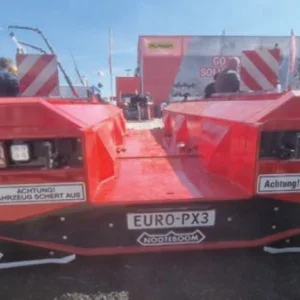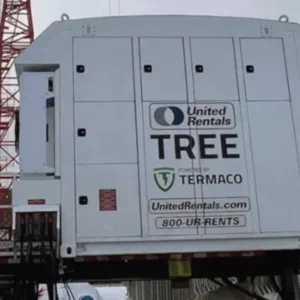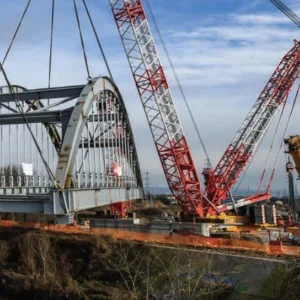Spain is a market that has been booming since about 1997, seemingly unchecked by the recent change in government that saw a lurch to the left. In recent years, approximately 2,500 new tower cranes have been sold every year (without considering the second hand units coming from other, mainly European, counties). It is also the world’s second biggest market for all terrain cranes and Europe’s second biggest for mobile cranes of all types.
Spain’s gross domestic product grew 2.4% in 2003 and is forecasted to grow 2.7% in 2004 and by 3.0% in 2005, according to OECD statistics. In 2003 Spain’s investment in construction rose 4% to Euro 112bn.
Towers
The health of the Spanish market has been excellent news for indigenous tower crane manufacturers Comansa and Jaso, as well as for Liebherr Industrias Metallicas (LIM), which also manufactures in Spain, and Potain, which has a factory in neighbouring Portugal. On the back of their strong home market, Comansa and Jaso are both also winning important export orders.
Jaso produces about 700 cranes a year, many for its own huge rental fleet. LIM produces about 600 cranes a year, of which about 400 are for the Spanish market. Comansa currently has a production capacity of 550 to 600 cranes a year, depending on size of crane. When Southeast Asia was the prime market, 10 years ago or so, fewer cranes could be made because the average size of the cranes produced was much larger. Most production today is for the home market, which demands smaller city-type cranes. The new LC 500, LC 1000 and LC 2100 are its most successful models, offering jib lengths ranging from 35m to 80m.
Comansa’s strategy is to specialise in modular flat-top tower cranes, making them easy to assemble and easy to service, and making it easier to ensure quality control as a manufacturer, since there are fewer variable components. Each family of cranes share sections, as well as standard motors and electrical components.
So successful has Comansa been (as has its local rival Jaso, also) that it is building a new, larger factory. It is just 3km from its current plant in Pamplona and Comansa plans to move there in September 2005. As well as increasing production capacity and shortening delivery times, the facilities at the new factory will help improve service provision, the company says.
Spain’s favoured tower crane is the city-type. Self-erecting tower cranes are not so common, comprising about 15% of the population, according to Comansa’s estimates, and are used mainly in rural areas.
Rental companies are now the main customer base, with construction companies just holding small fleets and hiring in the rest of their needs.
‘It was not like that in the past, but now – roughly speaking – we could say that 70% of our sales are for rental companies, and 30% for construction companies,’ says Comansa export manager Juan Mari Iturrate.
There are about half a dozen rental companies in Spain with fleets of more than 300 tower cranes (city crane size mostly), as well as about 30 more rental companies with more than 150 units.
Throughout the boom years, demand for tower cranes has been quite constant in Spain; demand dipped a little in 2003 but has returned in 2004. This year’s rise can be attributed to a new law introduced last year in Spain that says all tower cranes have to be in a minimum level of good working condition, so they are now strictly checked, says Iturrate. A lot of the very old machines disappeared and they are being replaced by new units.
According to Iturrate, tower crane demand has been fuelled by demand for construction of villas and apartment blocks in tourist regions. Anyone visiting any of the popular coast resorts on vacation cannot help but have noticed the number of tower cranes at work, mostly building housing developments for holiday accommodation. There is also a lot of demand from Britons and Germans seeking either an investment, a second home, or to escape the rain and the rat race altogether.
Bank loan interest rates loans have been controlled by the government and kept down, making property an attractive and reasonably safe investment.
Mobiles
All this construction activity has of course generated demand for other types of cranes. The market for rubber tyred mobile cranes in Spain has, as previously reported, matured from a used equipment and truck crane market to one that predominantly demands new German all terrains, and in such quantities that it is the world’s second largest AT market, behind Germany.
Twelve months ago there was a widely held view in the industry that 2004 would see a downturn from the peak of 334 new mobile cranes sold in 2002 (of which 321 were ATs, 10 were truck-mounted cranes and three were rough terrains). In the first quarter of 2003, there were 48 new mobile cranes sold in Spain – all of which were ATs. It looked like the boom was slowing. But by the end of the year, the total number of mobile cranes, remarkably, exactly equalled the result of the previous year – 334 new cranes sold, of which 321 were ATs. Only the Germans consume ATs more voraciously, taking about 470 ATs in 2003.
Surely Spain could not sustain these numbers in 2004? Well, yes. Apparently it can. To the surprise of many in the industry, Spain started 2004 phenomenally strongly, with 100 new mobile cranes shipped in the (usually slow) first quarter – more than double the 2003 first quarter result. Of these 100 deliveries, 96 were all terrains. When the numbers are collated for the first six months of the year, a rise of at least 10% on 2003 is confidently predicted.
Liebherr Ibérica claims a market share of 55%, with a significant number of sales of larger models. In the first half of the year it sold seven units of the new LTM 1400-7.1 (400t capacity). It also reports several orders for the new LTC 1055-3.1 compact crane (55t), which it says ‘has caused a tremendous impact among Spanish crane rental companies’. There have also been a number of orders for the 100t LTM 1100-4.1.
As previously reported, Tadano Faun has undergone a rebirth in Spain, shipping about 90 new ATs plus many used machines since the appointment of Mycsa as its distributor in August 2002. Mycsa’s appointment of Jenaro Vilanova as sales manager last year has further strengthened its team.
Recent deliveries include an ATF 110G-5, an ATF 160G-5 and a GR-700EXL Tadano rough terrain to Alfa Gruas. Large orders include 18 of the ATF 30-2 from the procurement co-operative CABA and an order for six ATs from Gruas Roxu ranging from 30t to 60t capacity. Faun’s bestseller in Spain, as elsewhere, is the ATF 80-4. According to Faun, the fuel-efficient approach of having two engines on this size of crane is winning it business.
Both Liebherr and Terex report that they have been taking in a lot of used equipment in part exchange for new machines and, such is the demand for new rather than used cranes, they are having to find new markets for them outside of Spain.
Curiously, it seems that the continued strength of mobile crane sales is a result of the boom being seen to have come to an end. Dani Orti, boss of rental company Gruas Orti, says that the mobile crane rental sector is in a state of transformation, with companies looking to reorganise and consolidate their position in the market in the face of a downturn in profitability. No longer, it seems, can anyone make money with an old 30 tonner. The market is too competitive and the work is harder to find. That explains why, for example, there was a marked drop in sales of 30 and 35 tonners in 2003 and a strong increase in sales of 60 tonners (with Tadano Faun leading the way). Rental companies are responding to the changing scene by increasing the quality of their fleets – with newer and larger models – and by emphasising service provision and injecting professionalism. Some are coming together in alliance to fund the purchase of large cranes.
‘Adapt or perish,’ Orti says.
As well as opening a new facility in Alicante this year, Gruas Orti has invested Euro 3m in new machinery, buying a 60t, an 80t and a 100t Liebherr all terrain, a Wumag aerial work platform and four truck loader cranes. With this approach, Orti is forecasting a growth in workload next year.
Orti says: ‘In my opinion, the great challenge which faces the sector is in offering a customised service to each client.’ The challenge is to change from being managers of machines to being managers of clients, he says. ‘And in this context, the new technologies play a vital role in the competitiveness and survival.’
This maturing of the market manifests itself in other ways too. Alfonso Garcia, CEO of newly-established HBC-Ibérica says that buyers of remote control systems, who are mainly users of tower, EOT or loader cranes rather than mobiles, are ‘very demanding’. He says: ‘Our Spanish users are very sophisticated and they tend to buy complex and long lasting equipment, with many additional features.
The market for new rubber tyred mobile cranes in Portugal is not so exciting, however. Total sales were 11 units in 2003, down from 16 units in 2002. This year’s first quarter saw just two new mobiles being bought in Portugal, compared with six in the first quarter of 2003. As in Spain, but on a much smaller scale, German all terrains account for most new crane sales in Portugal, although five of the 11 sold in 2003 were rough terrain models.
Crawlers
Though numbers remain relatively low, the crawler market in Spain doubled in 2003, primarily because of the expansion of the wind power sector. Leading wind farm constructor and manager Gamesa Energia has grown significantly in recent years, and now accounts for 46% of the Euro 1.6bn turnover of its parent corporation Gamesa. With 29 turbine parks in operation and a further eight in construction, it has now established its own crane division, called Setylsa. It has bought two of the new Liebherr LR 1400/2-W that was launched at Bauma earlier this year. This lattice boom crawler is particularly notable for its two slew rings that allow the chassis, the intermediate section with outrigger supports and the crane superstructure each to be repositioned in relation to one other as required,. This means that the whole machine can negotiate very tight corners. The crawler chassis is narrow, at just 4.8m wide; the star-shaped outriggers are 11.5m wide.
Setylsa has also bought two LTM 1400-7.1 all terrains, two LTM 1100-4.1s and an LTM 1300-6.1.
There is also reasonable demand for crawler cranes from ports and harbours and on coastal defences. For example, two new Kobelco CKE 2500 (250t capacity) machines are at work on coastal defence projects near Malaga and near Gibraltar, doing clamshell, lifting and piling work. The one near Malaga is owned by the Dutch company Hovago and on hire to foundation contractor Icecsa. The one near Gibraltar is owned by Van Adrighem, also of the Netherlands, and is on hire to Eurogruas. Both units were delivered by Kobelco direct to Spain earlier this year.
Recent Kobelco sales in Portugal include a CKE 1800 (180t) and a CKE 700 (70t) to the major civil engineering contractor tk which already owns a Kobelco 7150. The CKE 1800 is another machine destined for sea defence work.
Hitachi-Sumitomo is expecting to register some sales of its new telescopic crawler in Portugal and Spain, because of the strict transport regulations for rubber tyred machines. ‘Road construction requires good solutions where space is limited no truck cranes can be rigged. So an all terrain crawler is better in handling concrete pre-fabricated elements on the job,’ says Hemmo Luijerink, who manages Hitachi-Sumitomo’s European sales.
Loaders
Spain is also a significant market for truck loader cranes, which on many sites have taken over the work previously done by rough terrains and small truck cranes. Giovanni Fassi, managing director of leading Italian manufacturer Fassi, which claims to be the second biggest supplier in the Spanish market, says: ‘The Spanish market has always been one of the most important for Fassi Gru, which has been represented there since 1978 through the distributor Transgruas S.A.. The market is characterised by strong and steady growth due to the modernisation and development trends in civil engineering and infrastructures that Spain has witnessed since the early nineties. Quite apart from the expanding dynamics of the Spanish economy, Fassi’s market penetration has been particularly significant thanks to the skills of our dealer Transgruas, which has succeeded in building up a good reputation.’
When asked about its view of the markets in Spain, Palfinger injects a note of caution. In Spain, sales are strong in the booming building industry. ‘Therefore the overall market shows a very positive development; nevertheless the question is there if this development shows the realistic market size and conditions or if it is on an artificial high level,’ says Palfinger. It adds: ‘A certain uncertainty of future investments is present, especially after the recent change of the government. Also the price pressure becomes more and more a topic which has to be considered.
Portugal, though a very different market from Spain, with a less developed rental sector, is also reasonable market for loader cranes, says Palfinger. But while large loaders sell well in Spain (Fassi’s 80tm F800 is its best seller in Spain), the Portuguese market is more for mid-size loaders, although Giovanni Fassi says that cranes in the 60tm region are still popular.
‘The market in Portugal is more static, less dynamic than that in Spain,’ he says.
Harbour mobiles
The Iberian peninsular of Spain and Portugal is also a great market for mobile harbour cranes, judging by Liebherr’s experience. Liebherr’s Nenzing factory, which builds the LHM series of mobile harbour cranes, has shipped 44 units to Spain and Portugal since the introduction of its new range in 1996. Almost a quarter of these have been bought by Bergé Maritima in Bilbao.
Since 2002, nearly 18% of all Liebherr’s mobile harbour crane shipments have been to the Iberian peninsula. Demand remains strong this year, with seven orders from the region.
In March, Opemar in Malagar (Spain) took delivery an LHM 400G, the predominant crane type for this market, with a winch configuration of 2 x 70t. This was a repeat order: Opemar had already bought two LHM 250 cranes in 2000. The new machine, equipped with two four-rope grabs as before, will be used for handling both grain and clinker.
In May an LHM 150, equipped with 2 x 18t winch arrangement and a four-rope grab, was handed over to P&J Carrasco in Vilagarcía de Arousa, Spain.
In July OPM in Madeira, Portugal took delivery of an LHM 250 a maximum outreach of 38m, maximum lifting capacity of 64t, a fully automatic telescopic spreader for container handling, an on-board e-drive and a motor grab control system.
Two LHM 400G cranes were delivered in September to Bergé Maritima.
These cranes have an outreach of 48m and overall lifting capacity of 104t. They are fitted with one four-rope grab each for coal handling as well as an orange peel grab for scrap handling.
Yet to be delivered are orders for two LHM 500s, with one going Terminales Maritimas Servicesa (TMS) in Valencia, and one to Terminal Marítima de Huelva.






